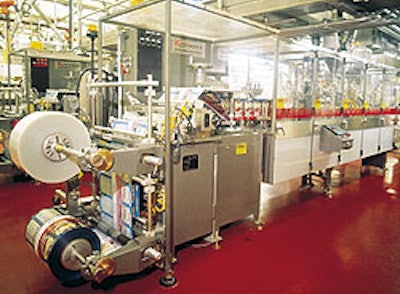When it was a brand owned by Borden Foods, Wyler’s Soup Starter turned around market sales declines by improving the product and switching from a canister to an innovative double pouch pack. The credit for the packaging transformation was owed to Borden’s Innovation Centre in Columbus, OH. It was closed after Pittsburgh-based H. J. Heinz purchased Wyler’s and other brands from Borden earlier this summer.
The Innovation Centre was responsible for developing several distinctive food products and equally inventive packaging for several of them. In fact, along with Wyler’s double pouch pack, the Centre also developed the Classico It’s Pasta Anytime line of shelf-stable meals that incorporate a different type of double pouch (see Packaging World, April ’00, p. 2).
For Wyler’s Soup Starter dry mix, the new stand-up pouch was developed by Borden packaging engineers with considerable help from converter Curwood, Inc. (Oshkosh, WI) and machinery manufacturer Klöckner Bartelt (Sarasota, FL).
Since the new package’s introduction a year ago, the brand has reversed a long-running sales decline. Last December alone, the brand’s sales were up more than 17%, exceeding the company’s forecast of 10% growth. “We’re pleased with Soup Starter’s performance,” said Michael Wellner, then acting brand manager. “The gusseted pouch has enabled us to bring new life to this brand by creating a more convenient, modern, and attractive shelf presence.
“The window in the front panel provides consumers a ‘what you see is what you get’ assurance of high-quality ingredients. The commercialization of the pouch and new flavors have set the stage for future growth on Soup Starter,” said Wellner, who is now with Jimmy Dean Foods.
A true upgrade
In the previous canister package, Borden used a separate paper/polyethylene/foil/PE pouch to hold the powdered soup stock and seasonings. It served to prevent moisture transfer from the dehydrated vegetables, pasta, and/or rice. This pouch was first inserted into the paper-based canisters that were formed on-line. Later, the dehydrated ingredients were filled on top of the pouch, and the canister was sealed with a polyester lidding film topped by a linear-low-density PE overcap.
That package had two major shortcomings. One, the consumer had trouble removing the seasoning pouch without first removing all the dehydrated ingredients. Second, the package was made up of many dissimilar components that compromised its efficiency.
Although the seasoning packet could have been inserted last, Borden’s Innovation Centre sought to solve both problems by updating the complete package. “We wanted to create a high-visibility package,” notes Rod Simpson, who served Borden as associate director of packaging research and development. “We knew the stand-up pouch was becoming increasingly popular with consumers, and so was product visibility. A flexible package with appropriate barrier properties was our first choice.”
It would also overcome the second obstacle of the canister. “We were dealing with six separate packaging components: the sidewall, bottom disc, hot melt adhesive, lidding film, and overcap. We wanted to simplify that,” Simpson said. He also asked Packaging World to credit several of his Innovation Centre associates for their work on the project: Eric Dietrich, Stephen Love, Jodi Pellegrin, and Guy Taylor. “They all helped make this package a success,” he says.
Two components now
After evaluating many options, Simpson and his fellow engineers designed a “membrane-style” stand-up pouch with a separate web of film used to segregate the two main ingredient combinations. He explains that the barrier film virtually eliminates any moisture transfer from the dry pasta or rice and dehydrated vegetables into the powdered stock and seasonings.
“We think it’s unique. There’s nothing like it in the marketplace,” Simpson says, “and it uses only two packaging components.” That’s because a stand-up pouch produced on a Klöckner Bartelt Model IM machine employs a folded bottom gusset, a “delta base.”
The outer pouch material is a 2.25-mil polyester/polyvinylidine chloride/sealant structure that Curwood prints by flexo in seven colors to a graphic design that was developed by Libby Perszyk Kathman (Cincinnati, OH). The inner pouch membrane is a proprietary coextrusion that Curwood declines to identify.
The key to the package development was the work of Klöckner engineers in modifying an IM pouch machine to handle the extra steps involved in creating and filling the two-compartment pouch. “We call this our ‘membrane upgrade conversion’ to the Bartelt IM machine,” says Lex Strayhorn, Klöckner account manager.
“We put a lot of effort into modifying the machine. Still, it only took about six months from inception of the program to completion of the machine.” Borden (now Heinz) operates two of these Bartelt machines at its Northbrook, IL, facility.
Membrane film is key
The IM machine employs 11 stations after the materials are pulled over the forming plow, Simpson tells PW. And the most critical part of the modification to the pouch maker is controlling the position of the membrane material, Strayhorn adds.
This Klöckner machine begins with the creation of the Delta base and seal. Even before that, the machine verifies the position of the membrane web. “This bottom seal is somewhat different from our normal Delta seal station,” says Strayhorn, “because the machine is also sealing the bottom of the membrane to the base.”
Along with the change in bottom sealing, the Borden machine requires three filling stations: one for seasonings, and the other two for vegetables and pasta or rice.
In addition, once the bottom and side seals are made, the pouch is filled with the seasoning mix, and the next station hot-tacks the membrane to the side of the outer pouch. This is done, according to Simpson, by using a hot seal bar on the back of the pouch and a cold seal bar on the front. Once the membrane compartment has been closed, another station blows open the outer pouch and is followed by two fillers that add the vegetables and other ingredients.
At another station, paddles press against the pouch to remove any excess air just before the top of the pouch and membrane are heat sealed together. Another station cools the seal area before pouches are discharged. Simpson reports that the pouch packager can be operated at speeds over 75/min.
Once pouches are ejected from the machine, each is conveyed through a metal detector from Safeline (Tampa, FL) and also over the platform of a checkweigher from Thermo Ramsey (Minneapolis, MN) prior to secondary packaging.
Because a tear notch is provided in sealing, the pouch is simple for the consumer to open to make one of seven varieties of soup. While the products are tasty by themselves, meats or other ingredients can be added to turn the soup into a full meal, according to the maker.
The repackaged Wyler’s Soup Starter has been a marketplace winner. First-half 2001 sales results were nearly 20% above projections, Wellner reported. (AO)





























